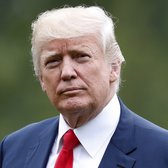Candidate Donald Trump said he would rebuild the Army and he was very specific in what he meant.
"We will build an active Army of around 540,000, as the Army's chief of staff has said he needs," Trump said Sept. 7, 2016. "We now have only 31 Brigade Combat Teams, or 490,000 troops, and only one-third of combat teams are considered combat-ready."
Trump's budget calls for an additional $54 billion for the base defense budget, or a total of $603 billion in FY 2018.
We are at the start of the budget process. It starts in the House and then passes over to the Senate, so we can't go beyond noting that Trump has offered a down payment on his promise.
That said, the Republican-controlled House Armed Service Committee voiced its concern with Trump's numbers. In a letter to the House Budget Committee, it said the money wouldn't be enough.
"That level of funding will not accomplish the administration's goals," chair Mac Thornberry, R-Texas, wrote. "Instead, we fear that it would unintentionally lock in a slow fix to readiness, consistent with the Obama Administration's previous position, from which we would not be able to dig out."
Thornberry said that about $640 billion would be needed to begin the process of repairing and rebuilding the country's military.
Todd Harrison, a fellow at the Center for Strategic and Budgetary Assessments in Washington, echoed the House committee's overall conclusion. The $54 billion would do little, he said.
"Most of it will be needed to cover cost growth in the current force and pay for the backlog of training and maintenance that has built up over the past few years," Harrison said.
By his count, to make good on the expansion Trump described during the campaign, Washington would need to spend $80 to $100 billion more in 2018 and then stay at that level.
Trump is also seeking an extra $25 billion in FY 2017. That would help him in his efforts, but still fall well short.
Harrison also emphasized that Trump, like President Barack Obama before him, needs Congress to go along with blowing through the budget caps required by the 2011 Budget Control Act. That is a considerable hurdle.
We'll see how the numbers shake out over Trump's term in office. For now, we rate this promise In the Works.

